#henry boxer gallery
Text




Foma Jaremtschuk (1907 - 1986, Russian)
The Artistic Universe Of Foma Jaremtschuk (1907 - 1986, Russian)
Foma Jaremtschuk is an artist of immense, spontaneous power. Though completely untrained and using only the simplest of materials, he created out of appalling living conditions a pictorial universe that is utterly compelling; at once horrific and a thing of terrible beauty. His cast of characters include large female nurses and guards, deformed doctors and orderlies, and a vast array of grotesque inmates and patients, including creatures that are hybrids of human, animal and machine. They interact in a surreal world, reminiscent in feeling to Franz Kafka’s nightmare spaces. Bathtubs take on the form of living, malevolent things, cupboards and ovens always seem to contain bodies or fish. Electrical equipment functions autonomously as shape-shifting device. As often as not his images are punctuated with fragments of angry and accusatory text that characteristically reduces to a kind of indistinct textual mumble, or develops into little rhymes whose charming simplicity jars with their profane content. These drawings are a unique record of a particular time and place in the USSR, created by an individual who was supremely sensitive to their most profound reality. In many drawings he faithfully described walls, fences, lights and loudspeakers that encircled the camp and ensured that there could be no escape. And if we were in any doubt as to in whose name these penal settlements were erected, the hammer and sickle flag of the Soviet Union and Comrade Stalin appears often on camp buildings.
We know very little about Jaremtschuk from the official record. Were it not for the survival of an extraordinary body of drawings he produced he would no doubt have disappeared into that mass stream of humans that come in to the world and leave it without leaving any lasting individual mark. Yet his life spanned most of the twentieth century. We know that he was born in a remote Siberian village in 1907, a decade before the revolution that was to change the Russian Empire forever and whose new social order would shape his adult life emphatically. And his death in 1986, in a psychiatric hospital for seriously ill and untreatable people, came only five years before the dissolution of the Soviet Union.
https://wrongwrong.net/.../foma-jaremtschuk-art-from...
Images are from Henry Boxer Gallery.
18 notes
·
View notes
Text




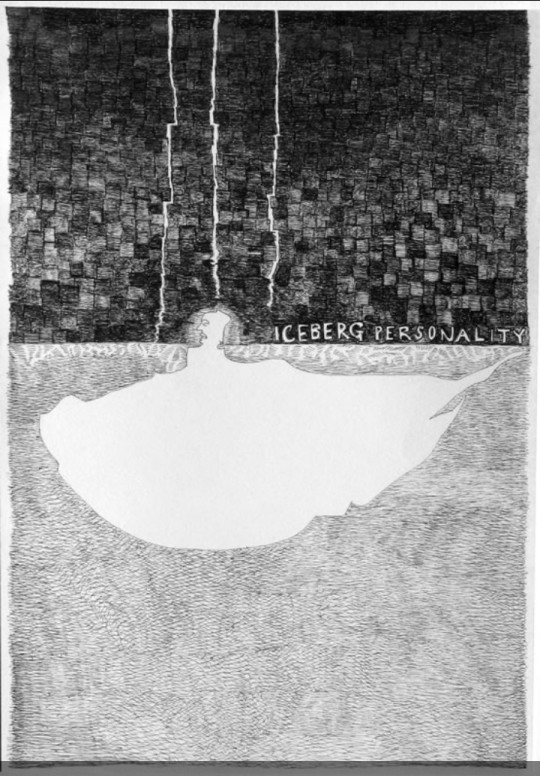



Drawings by/Disegni di Nick Blinko, Rudimentary Peni's vocals-guitar-artwork. Ink on paper. © Nick Blinko and Henry Boxer Gallery.
16 notes
·
View notes
Photo

Anna Zemánková
Henry Boxer Gallery Collection, currently on display Orleans House Gallery, Riverside Twickenham 'A Unique Vision'.
5 notes
·
View notes
Photo

Och, Kaplan, we barely knew ye...
Lt. Kaplan was the lead security guard in "The Apple," Somehow despite both being in front leading the way at some points, and guarding the rear in others, he manages to survive until Spock notices they are being followed. At that point, Kirk has Kaplan circle around toward the back of where they are standing.
And this is when....
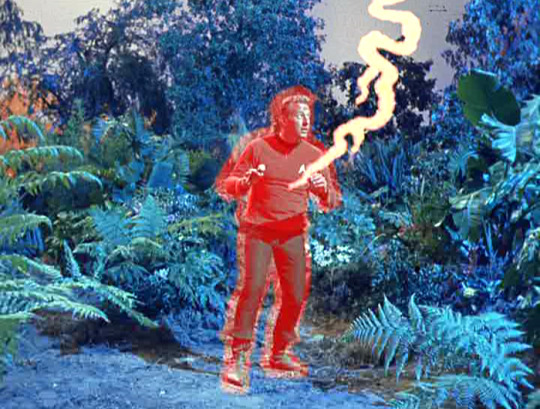
Lt. Kaplan becomes Krispy Kaplan and the second redshirt to die in the episode. Kirk bemoans the fact that he knew Kaplan’s family after they find the third dead redshirt (Mallory) and realizes he should have had the crew beamed back up at the first sign of trouble. Not that his realization helps Kaplan any now that he's a heap of ashes. And so we bid adieu to this fine young man in red.
But wait....
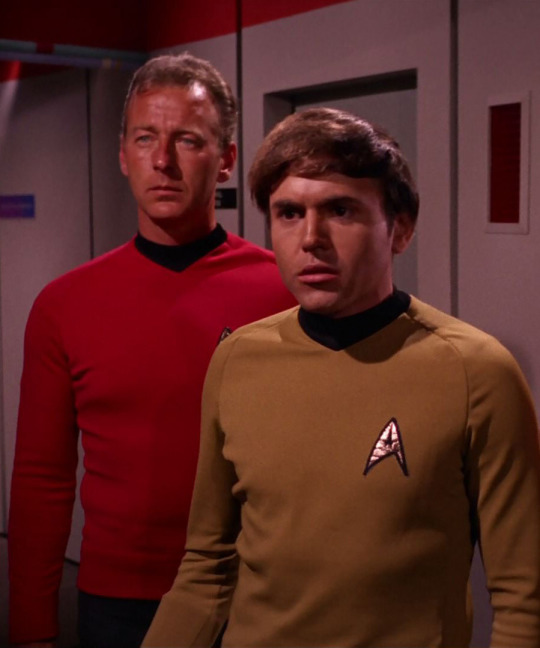
Someone who looks like Kaplan, but isn’t, shows up in “And The Children Shall Lead” as one of Chekov’s guards. Once a redshirt, always a redshirt. He’s doing fine until Chekov decides to start a fight and unfortunately, this guy draws....

Spock as his opponent. Not exactly a fair fight. And this leads to one of my favorite screenshots - a classic Vulcan nerve pinch and a very convincing look of agony from Spock’s target.
Both Lt. Kaplan and the security guard in “And the Children Shall Lead” were played by DIck (Richard Emile Ashley) Dial, Jr. He did have another acting part as one of the Fabrini guards in “The World Is Hollow and I Have Touched The Sky.”

But Dick Dial was primarily known as stuntman in Hollywood and Star Trek often used him in that regard as well. In the first season episode “Arena,” Dial was Shatner’s stunt double during the exciting fight scene with the Gorn. He also served as a stunt double for one of the Warriors in “Friday’s Child” and a general stuntman in “The Immunity Syndrome.”

As mentioned earlier, Dick Dial gained his fame mainly as a stuntman. But before that, he was an athlete at Classen High in Oklahoma City and also at the University of Oklahoma. Dial definitely had a well rounded sports background, which most likely helped him land work in Hollywood. He was a champion Golden Gloves boxer, a competitive sailor and a ranked tennis pro.
Dial began his Hollywood career in The Searchers as a stuntman, working along side Jeff Hunter in 1956 and landed a role as William Holden’s double on The Horse Soldiers. (Interestingly, both were John Wayne films). His Golden Glove championship came in handy when he landed work as one of the stuntmen in the boxing sequences in the Elvis Presley film Kid Galahad. This movie also had other TOS actors - Bill Zuckert, Louie Elias, and Seamon Glass. And he acted or performed stunts many other well known Hollywood movie stars such as Henry Fonda, Robert Duvall, Charlton Heston and Charles Bronson
The above photograph shows Dial as a character named Carson in the movie They Call Me Mr. Tibbs. He also was a stuntman in the same film. (This movie was mentioned in an earlier article on Charlie Washburn who was the second assistant director)
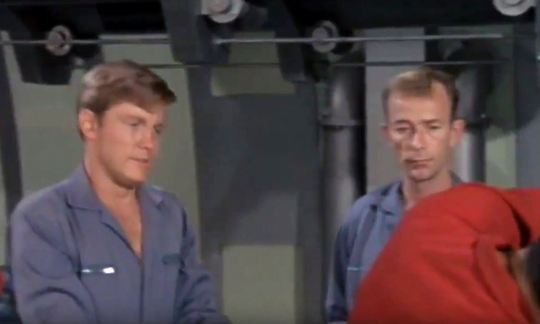
But Dick Dial had more success in television, starting with being Lloyd Bridge’s stunt double on Sea Hunt from 1958 to 1961 (he also doubled Bridges in a 1975-76 police series called Joe Forrester). Another series he worked on was The Fugitive where he doubled David Janssen from 1963-1967. Dial was seen often in small acting roles, such as the one above from Voyage to the Bottom of the Sea (second season episode “The Shape of Doom”) as well as The Man from U.N.C.L.E., The Time Tunnel, The Green Hornet, and Mannix.
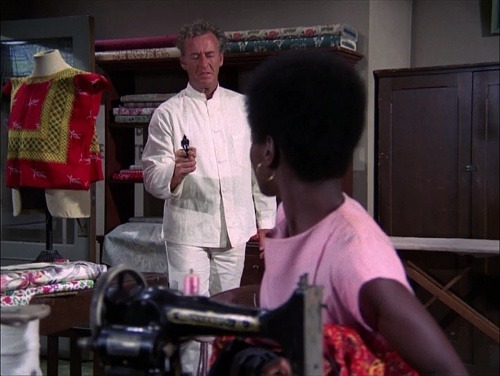
After his appearances in Star Trek, Dial continued his acting career with appearances on The Mod Squad, The Felony Squad, and Mission Impossible. His appearance (seen above) in the 5th season Mission Impossible episode “Hunted” was particularly amazing because he was actually playing the character Barney in disguise (played by Greg Morris, whose son Phil appeared as one of the children in the TOS epiosde “Miri.”)
But this was not Dick Dial’s only association with Mission Impossible. He was Peter Graves’ stunt double for 89 episodes. His final long term stint as a stunt double was for Robert Loggia in Mancuso, FBI ( 20 episodes).
However, Dick Dial had a life beyond the screen. In his off time, he sailed competitively and was an “A” ranked tennis player. One of the members of a discussion board for Dick Dial on Memory Alpha remembers him as his Little League coach from 1968 to 1971.
Earlier in life, he had taken classes at the Art Institute of Chicago. So it should be no surprise he continued to use that talent later in life. Dial’s caricatures of celebrities and friends were hung in two well-known Hollywood restaurants owned by a friend of his (La Scala Presto and La Scala Malibu) . He also did humorous political cartoons that were published in papers such as the LA Times. Many of his oil paintings were considered to be gallery quality. Unfortunately, very few of these can be seen (other than in photos) and his daughter DuPree Dial is still looking for them. If you think you may have one, look for the name DIAL in the bottom right hand corner. Of all Star Trek memorabilia you could have, this may be one of the rarest. Think of it - how wild would it be to own a piece of art from a man whom Mike Douglas (a popular TV host in the 60s and 70s) referred to as “The Hollywood Stuntman.”
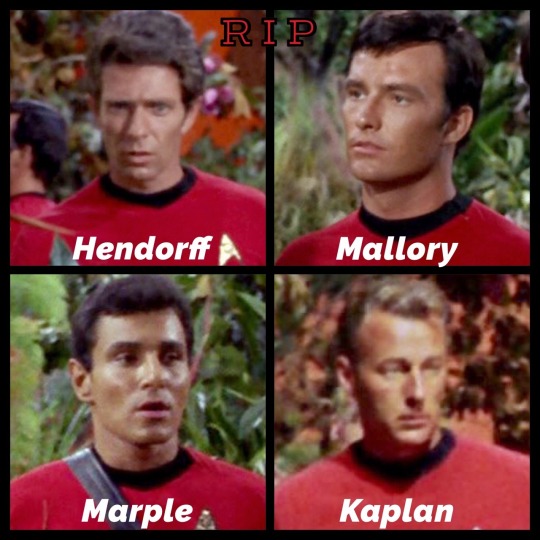
Someone on Tumblr with the name "Frank-o-meter" constructed this handy dandy chart of redshirts in "The Apple." It provides a nice way to pay tribute to Kaplan and his fellow comrades in red. And a reminder that with Kaplan, we have covered most of the information known on the actors who portrayed them.
Hendorff - https://www.facebook.com/talesoftheunknownredshirt/posts/1732560857049439
Mallory - www.facebook.com/talesoftheunknownredshirt/posts/2099712617000926
Marple - (recently appeared in the article on THE VELVET VAMPIRE)
Above panel taken from the following Tumblr post -
https://frank-o-meter.tumblr.com/post/157117085705/star-trek-rest-in-peace-part-3-all-but-one
7 notes
·
View notes
Photo

William A. Hall was homeless for 18 years before his intricate colored pencil drawings of vehicles and futurescapes were discovered and brought to the public. During the past few years, his work has been displayed by Henry Boxer Gallery and brought to museum collections specializing in folk and outsider art. See more on HiFructose.com.
306 notes
·
View notes
Text
About Barry
Barry Sheene, Motorcycling's first superstar
Earlier Life
Born in London, Barry was the second child of parents Frank (resident engineer at the Royal College of Surgeons, himself a former competitive rider who retired in 1956 and an experienced motorcycle mechanic) and Iris. He grew up in Queen Square, Holborn, London. Before entering road racing Sheene found work as a messenger and delivery driver.
Racing Career
Barry first started to race in 1968, winning his first races at Brands Hatch riding father Frank's 125 cc and 250 cc Bultacos. He became the British 125cc champion at age 20 in 1970. In 1971 riding an ex-works 1966 10-speed Suzuki twin, previously ridden by Stuart Graham he finished second in the 125 cc World Championship. His first Grand Prix win coming on that bike at Spa in Belgium, soon followed by a win on a 50 cc Van Veen Kreidler at Brno in Czechoslovakia, where he finished over two and a half minutes ahead.
For 1972 Barry was signed to the works Yamaha team for the 250 cc World Championship. However, at the third round in Austria, after losing a sprint to the finish line to the Australian John Dodds for third place, he voiced his displeasure to team management about the performance of the bike and was dropped from the team with immediate effect. His works Yamaha YZ635 was then given to the Finnish rider, Jarno Saarinen who went on to use the bike to win the World Championship that year.
Barry was signed by Suzuki during the off season 1972–1973 and won the newly formed Formula 750 European championship for them in 1973. As a works Suzuki rider Sheene had two contracts, with the World Championship events taking precedence over his Suzuki GB contract for home and International events, if any race dates clashed.
For 1974 Suzuki introduced the RG500 which Sheene rode to a second, third and a fourth scoring 30 points and finishing sixth in the World Championship.
A spectacular crash at the Daytona 200 in the 1975 season threatened to end his career, breaking his left thigh, right arm, collarbone and two ribs, yet he recovered and was racing again seven weeks afterwards. Again riding the RG500 he scored a memorable first 500 cc win at the Dutch TT.
In the 1976 season, he won five 500cc Grands Prix, bringing him the World Championship. He took the Championship again in the 1977 season with six victories. For the 1977 season Sheene was partnered by Steve Parrish, who rode Barry's 1976 Suzuki 500 cc machine.
Barry's battle with Roberts at the 1979 British Grand Prix at Silverstone has been cited as one of the greatest motorcycle Grand Prix races of the 1970s. After the 1979 season, he left the Heron-Suzuki factory team, believing that he was receiving inferior equipment to his team-mates. He switched to a privateer on a Yamaha machine, but soon started receiving works equipment. In 1981, Kenny Roberts the reigning World 500cc Champion for the third time in succession. Sheene, by now on a competitive Yamaha, was determined to take the championship from him. Ironically, Sheene and Roberts battled all season and let Suzuki riders Marco Lucchinelli of Italy and American Randy Mamola beat them for the top two spots. Roberts finished third and Sheene fourth in the final World Championship standings.
A crash at Silverstone where Sheene, riding his Yamaha, hit the obscured fallen machine of Frenchman Patrick Igoa during practice for the 1982 British Grand Prix largely ended his potential as a title threat, and he retired in 1984. He remains the only rider to win Grand Prix races in the 50cc and 500cc categories.
Barry was known for being outspoken in his criticism for what he considered to be dangerous race tracks, most notably, the Isle of Man TT course, which he considered too dangerous for world championship competition. He was a colourful, exuberant character who used his good looks, grin and London accent to good effect in self-promotion, and combined with an interest in business was one of the first riders to make a lot of money from endorsements. He is credited with boosting the appeal of motorcycle racing into the realm of the mass marketing media. He also tried his hand as a TV show host, including the ITV series Just Amazing!, where he interviewed people who had, through accident or design, achieved feats of daring and survival (including the former RAF air gunner, Nicholas Alkemade, who survived a fall of 18,000 feet without a parachute from a blazing Avro Lancaster bomber over Germany in March 1944). Sheene and his wife Stephanie also starred in the low-budget film Space Riders.
Personal Life
In 1975 while on crutches, Barry met model Stephanie McLean, the couple married in 1984, having a son Freddie and daughter Sidonie.
Emigration to Australia
The Sheene family moved to Australia in the late 1980s, in the hope that the warmer climate would help relieve some of the pain of Barry's injury-induced arthritis, settling in a property near the Gold Coast. He combined a property development business with a role as a commentator on motor sport. He began on SBS TV then moved to the Nine Network with Darrell Eastlake, and finally followed the TV broadcast rights of the Grand Prix motorcycle series to Network Ten. Further to this, on Network Ten Barry co-hosted the weekly motor sport television show RPM from 1997 to 2002 with journalist Bill Woods, and was involved in Ten's coverage of other motor sport including V8 Supercars for several years.
In the 1990s, Barry appeared in a series of well known and popular television advertisements for Shell, with Australian motor sport icon Dick Johnson. In later years, Barry became involved in historic motorcycle racing, often returning to England to race at Donington Park. He was also chosen to run with the Queen's Baton in the run-up to the 2002 Commonwealth Games held in Manchester, England.
Death
In July 2002, at the age of 52, Barry was diagnosed with cancer of the oesophagus and stomach. Refusing conventional treatments involving chemotherapy, Barry instead opted for a holistic approach involving a strict diet devised by Austrian healer Rudolf Breuss, intended to starve the cancer of nourishment. He died peacefully surrounded by his family at a hospital on Queensland's Gold Coast in 2003, aged 52, having suffered from the condition for eight months.
Honours and Awards
Following reconstruction of the Brands Hatch Circuit in England for safety concerns after requests by the F.I.M., the Dingle Dell section was changed for safety, and shortly after Barry's death the new section was renamed Sheene's Corner in his honour. The FIM named him a Grand Prix "Legend" in 2001. For the 2003 season, V8 Supercars introduced a medal in honour of Barry, the Barry Sheene Medal, for the 'best and fairest' driver of the season. A memorial ride from Bairnsdale, Victoria to Phillip Island is held by Australian motorcyclists annually, before the MotoGP held at the island.
In Popular Culture
On a side note, the obscure Eric Idle song "Mr. Sheene" which describes "Mr. Sheene's riding machine" appears to be about Barry Sheene. It was released as a B-side of the 1978 single "Ging Gang Goolie" and is credited as released by Rutles-offshoot duo "Dirk and Stig." He is also featured on one of Artist Grayson Perry's Vases My Heroes (1994). Barry also featured in a number of Brut adverts alongside boxer Henry Cooper.
Image © Gerard Kampen. All Rights Reserved © Estate of Barry Sheene. Managed by Santara Group
HOME
ABOUT BARRY
GALLERY
ART
BOOK
THE ESTATE
CONTACT US
This site uses cookies to personalize your experience, analyze site usage, and offer tailored promotions. www.youronlinechoices.eu Remind me later I accept
3 notes
·
View notes
Text
Is Outsider Art the sincere Art as in comparison to academic art which is bounded by rules, outlines, history of art.
0 notes
Text
"Tadao Ando's equivalent of what a dog does to a lamppost"
The redesign of Paris' Bourse de Commerce in Paris by architect Tadao Ando is a "complete disaster" of sterile concrete that turns the building into a monument to French colonial violence, says Aaron Betsky.
A billionaire and an architect walked into a bar. "What will you have?" the bartender asked. "Something to forget the evil origins of capitalism," the billionaire replied. "I need something to make me feel big and important," said the architect.
"I have the perfect thing for you," the bartender responded; "A concrete martini. It is round, dry, aseptic, and big enough to make you feel like you own the world."
"Make mine a double," the architect responded with enthusiasm.
That is how I imagine the origin story of the Pinault Collection's new venue in the Bourse, Paris' former stock exchange. It features a concrete ring whose functions, such as they are, appears to be to support two spindly staircases and some air outlets.
But its real nature seems to be architect Tadao Ando's equivalent of what a dog does to a lamppost, it is an example of money trying to transform itself into art and architecture at a gigantic scale. As a display space for a pretty good collection of contemporary art, it more or less succeeds. As an example of contemporary architecture, it is a complete disaster.
It is an example of money trying to transform itself into art and architecture at a gigantic scale.
The Bourse is a building of note. Its basic structure is that of the Halle aux blés, the grain exchange that it housed between 1767 and 1873. After its wooden dome burned down in 1802, Jean Francois Belanger redesigned it to offer not only a functional interior clothed with a classical exterior of great refinement but also to show off the new structure of iron and glass (ferrovitreous architecture, for the nerds) with great panache.
When it became the stock exchange in 1885, Henri Blondel redesigned it in a simpler manner, while five different artists added paintings around the central rotunda that glorified French colonial power. After years of neglect and misuse, the Bourse fell into the hands of one of France's two Titans of Luxury (the other being Bernard Arnault, who, although controlling the greater empire of LVMH, had to console himself with a somewhat better Frank Gehry building on the outskirts for his LVMH Foundation).
Pinault actually has an eye – or has eyes who work for him – and has thus built up a collection of contemporary art that is not only strong but also consistent, concentrating on representational work that ranges from the surreal to the evocative to the hyper-realistic. He collects in depth, and the galleries with work after work by Peter Doig, Marlene Dumas, David Hammons, or Kerry James Marshall are enough to make you forgive many (if not all) sins.
Unfortunately, Pinault also loves Tadao Ando, the former boxer whose work always photographs much better than it is. Ando, in turn, loves concrete and pure geometry. He does not seem to care where he puts his circles and squares. He works with clients, such as Pinault, who can help him assure that the concrete is as fine as marble. The two already strutted their stuff in Venice's Palazzo Grassi and Punta della Dogana, but now they have plunked themselves down in the heart of Paris.
It should have been a job of restoration and that effort has been done with great care by Pierre Antoine Gatier (France's Director of Historic Buildings) and a studio called NeM. The building and its decoration look as if they were finished a few days ago, and most new services have been tucked away with all the skill that good design and money can afford.
The only evidence of friction is the battalion of new lights hanging from the ceilings and the light that, despite scrims, rakes paintings with light. In the basement, the concrete continues as the walls of a small auditorium that is intimate and pleasant, while visitors have the chance to explore the original air conditioning equipment, which is as intricate and beautiful as any of the works of art on display above.
Obscuring everything but the dome, the circle creates a central space that I am sure will be great for parties.
If Ando had shown his generosity by concentrating on how all that worked and by adding those touches that would form an apt counterpoint to the existing structure, it would have been enough. However, he felt it necessary to follow up the work he did for Pinault in Venice by inserting the concrete walls that are his trademark. Here, they mainly take the form of a circle he erected on the former trading floor.
Obscuring everything but the dome, the circle creates a central space that I am sure will be great for parties, and that currently house a few nicely ironic sculptures that turn out to be melting candles, created by Urs Fischer.
Their other function is to provide a secondary staircase to the upper levels, and an outlet for air. The latter causes a lip to protrude that manages that only to ruin one's view of the architecture from the floor but does the same from the balconies above. There is no art hung on these massive walls.
Do we really have to look at Black people serving and doing obeisance to their conquerors one more time?
What that space really needs is not some Ando-ness, but some context or relativizing of the frieze on the dome above it. Do we really have to look at Black people serving and doing obeisance to their conquerors one more time, especially if it is in what is not a particularly good painting? Do we really need to stand in a sanitised place of exploitation through money, ironised only by wry sculptures, but monumentalised by architecture?
The artists whom Pinault has collected can hope that their messages, which are critical, evocative, and in some cases powerful beyond any Gucci bauble the billionaire can sell us, will cut through the conditions in which they are shown –although the white walls, fancy lights, and aestheticizing an in-your-face artist such as David Hammons confronts here makes you wonder about that.
The architect could have done a much better job digging, excavating, exposing, and confronting the two centuries of material present here. Instead, Ando not only drank his concrete martini but created an affectless tomb for all those who suffered and died to make this display possible.
The main photo is by Patrick Tourneboeuf.
Aaron Betsky is director of Virginia Tech School of Architecture and Design and was president of the School of Architecture at Taliesin from 2017 to 2019. A critic of art, architecture, and design, Betsky is the author of over a dozen books on those subjects, including a forthcoming survey of modernism in architecture and design. Trained as an architect and in the humanities at Yale University, Betsky was previously director of the Cincinnati Art Museum (2006-2014) and the Netherlands Architecture Institute (2001-2006), and curator of architecture and design at the San Francisco Museum of Modern Art (1995-2001). In 2008, he directed the 11th Venice International Biennale of Architecture.
The post "Tadao Ando's equivalent of what a dog does to a lamppost" appeared first on Dezeen.
0 notes
Photo

Angelica, Smiling Sun, 1940- 1948, 5 x 7 in. via Henry Boxer Gallery
0 notes
Photo



both pictures: Untitled, c. 1946, courtesy Henry Boxer Gallery
Raw Vision Featured Artist:
Scottie Wilson (1888–1972)
Scottie Wilson (born Louis Freeman), was a near-illiterate Glaswegian junk dealer living in Canada. In the early 1930s, Wilson one day became captivated by a particularly fine gold-nibbed fountain pen. Feeling the compulsion to draw, he became intensively involved, drawing swirling sinister faces, organic forms and abstract patterns which he hatched and filled with ink.
Many of his pictures include central figures which he called his “Meanies” or “Greedies”. He surrounded many of them with contrasting natural images, particularly flowers and fish, using his linear technique. Some of his drawings are densely coloured, the designs filled with inks, surrounded by a vibrant background. Others are set against a white background and the colours are more muted. Wilson’s early drawings have a freer expressive line with few elements.
His work gradually became more intricate, his line tight and controlled. In his later years his drawing became more decorative, with fewer motifs. In the 1950s, Wilson became very successful following his acceptance by London’s Surrealist set. He had several exhibitions and his work was collected by Picasso and André Breton, and Victor Musgrave included his drawings in his Outsider Archive collection.
Scottie Wilson is featured in our Outsider Art Sourcebook and Raw Vision 89 (both currently half price) and in the PDF version of Raw Vision 47.
3 notes
·
View notes
Text
Jim Crow and Jemima Crow
"Jim Crow" and "Jim-Ima Crow"
You've probably heard about Jim Crow before, but have you ever heard of Jemima Crow?
William Henry Hunt was one of the most distinctive and influential of early Victorian watercolor artists, who was easily identified with his naturalistic still life detailed compositions.
He is well known for his style of watercolor and landscape painting, but started doing more figurative artwork after the year 1824, depicting subjects that are often comical or appealing to the emotions of the viewer.
Winsome children humorously aping the manners of adults were a popular subject for genre scenes. In the 1830s the artist William Henry Hunt exhibited a series of twenty such images at the Old Water Colour Society in London. These were later produced as lithographs and published as Hunt’s Comic Sketches (1844).

© Victoria and Albert Museum, London
[Alternate via The British Museum]
The series included two images of black children. This image, which was originally exhibited as 'Jim Crow' was re-titled 'Master James Crow – Out of his Element', and its companion piece below, 'Miss Jem-ima Crow', re-titled 'Miss Jim-Ima Crow – A West Indian Cinderella'.

© Victoria and Albert Museum, London
Artist: William Henry Hunt, (1790 - 1864)
Lithographer: Thomas Fairland, (1804 - 1852)
Both works appear to have been painted from living models who have been posed with studio props to suggest a narrative. James Crow (whose name references ‘Jim Crow’ the comic blackface act first seen in London in 1836, pictured on a poster above Jim-Ima) is ‘out of his element’, i.e. away from the heat of his supposed homeland, and has to warm himself in front of the stove. Tending the fire was a common duty of black domestic servants in British homes, many of whom were boys or young men.
Jim-Ima Crow kneels by the hearth, bellows in hand, tending the fire and the coffee pot. Like Jim-Ima, coffee was another form of colonial export.
Could she have grown up and become the same Aunt Jemima we know today?
Sources:
https://collections.vam.ac.uk/item/O127673/master-james-crow-print-hunt-william-henry/
https://collections.vam.ac.uk/item/O127675/miss-jim-ima-crow-print-hunt-william-henry/
Here’s some of Hunt’s more normal-looking non-caricatured works featuring black children:
The first 2 portraits are based on the same model who is even wearing the same coat. This was undoubtedly a real person that may very well have lived in the artist’s own community at the time or around his London studio.

Mulatto Boy, ca. 1830-1840
© Victoria and Albert Museum, London

A Brown Study, ca. 1840
© Victoria and Albert Museum, London
[Alternate via the Yale Center for British Art]

Light and Shade, 1836
[Alternate Version]

Negro Boxer, 1830
You can read a biography for William Henry Hunt Ows here:
(via the Chris Beetles Gallery)
http://www.chrisbeetles.com/artists/hunt-william-henry-ows-1790-1864.html#
#black history#stereotypes#jim crow#jemima crow#aunt jemima#medievalpoc#history#british history#european art history#art history#racism
3 notes
·
View notes
Text
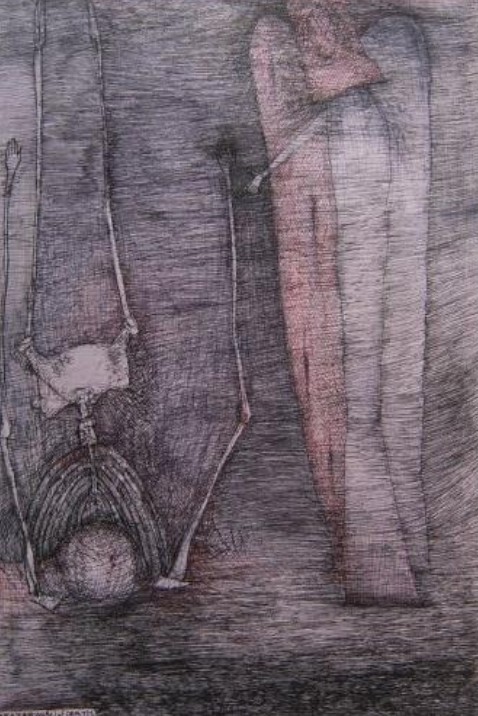
"Death & Angel Of Death", by Nick Blinko. Ink on paper. © Nick Blinko and Henry Boxer Gallery.
14 notes
·
View notes
Photo


Art by the spiritual painter Margot. She is represented by Henry Boxer Gallery.
Here is an article from the gallery's site.
"My name is Margot.This is the name I have chosen. I was born on July 25, 1982 and grew up in the countryside.
When I was 32 years old and I started drawing tirelessly.Before that, I realised florist studies.
I tried to do like everyone else. I learnt a job and entered into the dizzying circle of what the world offers me at this moment.I got a job and then I became a business manager. "All was well in the best of all worlds".
But my future was to be different.
I changed my route, I forked. I stopped everything.My subconscious knew that my future was somewhere else.
The year 2014 was a radical change in the way I see life, my future, and how I was going to use my energy.
One cycle ended, another began.I stopped my work. Back to the family home. It's an upheaval.
Something was telling me it's time to move on ... and it was in October 2014 that I've started to draw. Everyday. All day.this energy was like a torrent, indeed it was frenetic and furious.With time, I have found my rythm.I imbricate the lines, I multiply the features and I give birth to the forms.
Then I assemble the curves with fluidity. A rhythmic is created, similar to music, to emotions.Through my drawings, I compose with the vibrations surrounding me, I give birth to a new universe and I transcend my memories.I free myself, I break my chains. I breathe .......... deeply.
Always with my favorite materials: paper, pens and Indian ink.By The way I create, I give body to my visions, I make real my utopia of a timeless world where the Beings would be free from the power and its attraction.From my sanctuary I aspire to a new era.
Her comments about her 'Utopian Constructions'...« A l'aide de multiple bout de papiers , je construis des architectures, semblables à des refuges , une cabane dans un arbre, où mon esprit peut battre en retraite .
Tel un exutoire je viens calmer mes pensées et mes réflexions sur le monde qui m'entoure :Territoire inviolable où seuls les protecteurs de mon sanctuaire s'enracinent. »
“With the help of multiple pieces of paper, I build architectures, similar to shelters, a cabin in a tree, where my mind can retreat.Like an outlet I come to calm my thoughts on the world around me: inviolable territory where only the protectors of my sanctuary take root”
https://www.outsiderart.co.uk/artists/margot
5 notes
·
View notes
Photo

The Colored Pencil Futurescapes of William A. Hall http://hifructose.com/2019/01/22/the-colored-pencil-futurescapes-of-william-a-hall/ William A. Hall was homeless for 18 years before his intricate colored pencil drawings of vehicles and futurescapes were discovered and brought to the public. During the past few years, his work has been displayed by Henry Boxer Gallery and brought to museum collections specializing in folk and outsider art.
More
January 22, 2019 at 08:05AM
0 notes
Text
February 25
February 25, 1870 Hirman R. Revels of Mississippi sworn in as first Black U.S. senator and first Black representative in Congress. February 25, 1928 "One-Man Show of Art by Negro, First of Kind Here, Opens Today," read the headline of a front-page article in 'The New York Times' on this day. The article announced the opening of Archibald J. Motley, Jr's show at the New Gallery on Madison Avenue. This was the first time in History that an artist had made the front page of 'The New York Times' and it was the second one-person show by an African-American artist (the first being Henry O. Tanner). African scenes, voodoo dances, and African-Americans at leisure were themes presented by the artist. February 25, 1964 Nat King Cole, the singer with the "Golden Voice", dies. Muhammad Ali defeated Sonny Liston for world heavyweight boxing championship. February 25, 1975 Death of Elijah Muhammad (77), leader of the Nation of Islam, in Chicago. He was succeeded by his son, Wallace D. Muhammad. February 25, 1978 Death of Daniel ("Chappie") James Jr. (58), retired Air Force general and the first Black promoted to four-star rank, at the Air Force Academy, Colorado. February 25, 1989 Boxer Mike Tyson becomes the undisputed Heavyweight Champion of the World by defeating challenger Frank Bruno of England. February 25, 1991 Adrienne Mitchell, first African American woman to die in combat in the Persian Gulf War is killed in her military barracks in Dharan, Saudi Arabia February 25, 1998 R. Kelly's hit single "I Believe I Can Fly" win Best Male R&B Vocal, Best Song Written for TV or a Movie and Best R&B Song Grammy Awards. February 25, 1999 White supremacist John King, one of three white men accused of chaining James Byrd to a pickup and dragging him along a Texas road until he was decapitated, was sentenced to death by lethal injection. If his death penalty is carried out, he will be the first white Texan executed for killing a black since slavery ended. #TheMoreYouKnow #BlackExcellence #BlackHistoryMonth #ThisDayInHistory
1 note
·
View note
Text
About Barry
Barry Sheene, Motorcycling's first superstar
Earlier Life
Born in London, Barry was the second child of parents Frank (resident engineer at the Royal College of Surgeons, himself a former competitive rider who retired in 1956 and an experienced motorcycle mechanic) and Iris. He grew up in Queen Square, Holborn, London. Before entering road racing Sheene found work as a messenger and delivery driver.
Racing Career
Barry first started to race in 1968, winning his first races at Brands Hatch riding father Frank's 125 cc and 250 cc Bultacos. He became the British 125cc champion at age 20 in 1970. In 1971 riding an ex-works 1966 10-speed Suzuki twin, previously ridden by Stuart Graham he finished second in the 125 cc World Championship. His first Grand Prix win coming on that bike at Spa in Belgium, soon followed by a win on a 50 cc Van Veen Kreidler at Brno in Czechoslovakia, where he finished over two and a half minutes ahead.
For 1972 Barry was signed to the works Yamaha team for the 250 cc World Championship. However, at the third round in Austria, after losing a sprint to the finish line to the Australian John Dodds for third place, he voiced his displeasure to team management about the performance of the bike and was dropped from the team with immediate effect. His works Yamaha YZ635 was then given to the Finnish rider, Jarno Saarinen who went on to use the bike to win the World Championship that year.
Barry was signed by Suzuki during the off season 1972–1973 and won the newly formed Formula 750 European championship for them in 1973. As a works Suzuki rider Sheene had two contracts, with the World Championship events taking precedence over his Suzuki GB contract for home and International events, if any race dates clashed.
For 1974 Suzuki introduced the RG500 which Sheene rode to a second, third and a fourth scoring 30 points and finishing sixth in the World Championship.
A spectacular crash at the Daytona 200 in the 1975 season threatened to end his career, breaking his left thigh, right arm, collarbone and two ribs, yet he recovered and was racing again seven weeks afterwards. Again riding the RG500 he scored a memorable first 500 cc win at the Dutch TT.
In the 1976 season, he won five 500cc Grands Prix, bringing him the World Championship. He took the Championship again in the 1977 season with six victories. For the 1977 season Sheene was partnered by Steve Parrish, who rode Barry's 1976 Suzuki 500 cc machine.
Barry's battle with Roberts at the 1979 British Grand Prix at Silverstone has been cited as one of the greatest motorcycle Grand Prix races of the 1970s. After the 1979 season, he left the Heron-Suzuki factory team, believing that he was receiving inferior equipment to his team-mates. He switched to a privateer on a Yamaha machine, but soon started receiving works equipment. In 1981, Kenny Roberts the reigning World 500cc Champion for the third time in succession. Sheene, by now on a competitive Yamaha, was determined to take the championship from him. Ironically, Sheene and Roberts battled all season and let Suzuki riders Marco Lucchinelli of Italy and American Randy Mamola beat them for the top two spots. Roberts finished third and Sheene fourth in the final World Championship standings.
A crash at Silverstone where Sheene, riding his Yamaha, hit the obscured fallen machine of Frenchman Patrick Igoa during practice for the 1982 British Grand Prix largely ended his potential as a title threat, and he retired in 1984. He remains the only rider to win Grand Prix races in the 50cc and 500cc categories.
Barry was known for being outspoken in his criticism for what he considered to be dangerous race tracks, most notably, the Isle of Man TT course, which he considered too dangerous for world championship competition. He was a colourful, exuberant character who used his good looks, grin and London accent to good effect in self-promotion, and combined with an interest in business was one of the first riders to make a lot of money from endorsements. He is credited with boosting the appeal of motorcycle racing into the realm of the mass marketing media. He also tried his hand as a TV show host, including the ITV series Just Amazing!, where he interviewed people who had, through accident or design, achieved feats of daring and survival (including the former RAF air gunner, Nicholas Alkemade, who survived a fall of 18,000 feet without a parachute from a blazing Avro Lancaster bomber over Germany in March 1944). Sheene and his wife Stephanie also starred in the low-budget film Space Riders.
Personal Life
In 1975 while on crutches, Barry met model Stephanie McLean, the couple married in 1984, having a son Freddie and daughter Sidonie.
Emigration to Australia
The Sheene family moved to Australia in the late 1980s, in the hope that the warmer climate would help relieve some of the pain of Barry's injury-induced arthritis, settling in a property near the Gold Coast. He combined a property development business with a role as a commentator on motor sport. He began on SBS TV then moved to the Nine Network with Darrell Eastlake, and finally followed the TV broadcast rights of the Grand Prix motorcycle series to Network Ten. Further to this, on Network Ten Barry co-hosted the weekly motor sport television show RPM from 1997 to 2002 with journalist Bill Woods, and was involved in Ten's coverage of other motor sport including V8 Supercars for several years.
In the 1990s, Barry appeared in a series of well known and popular television advertisements for Shell, with Australian motor sport icon Dick Johnson. In later years, Barry became involved in historic motorcycle racing, often returning to England to race at Donington Park. He was also chosen to run with the Queen's Baton in the run-up to the 2002 Commonwealth Games held in Manchester, England.
Death
In July 2002, at the age of 52, Barry was diagnosed with cancer of the oesophagus and stomach. Refusing conventional treatments involving chemotherapy, Barry instead opted for a holistic approach involving a strict diet devised by Austrian healer Rudolf Breuss, intended to starve the cancer of nourishment. He died peacefully surrounded by his family at a hospital on Queensland's Gold Coast in 2003, aged 52, having suffered from the condition for eight months.
Honours and Awards
Following reconstruction of the Brands Hatch Circuit in England for safety concerns after requests by the F.I.M., the Dingle Dell section was changed for safety, and shortly after Barry's death the new section was renamed Sheene's Corner in his honour. The FIM named him a Grand Prix "Legend" in 2001. For the 2003 season, V8 Supercars introduced a medal in honour of Barry, the Barry Sheene Medal, for the 'best and fairest' driver of the season. A memorial ride from Bairnsdale, Victoria to Phillip Island is held by Australian motorcyclists annually, before the MotoGP held at the island.
In Popular Culture
On a side note, the obscure Eric Idle song "Mr. Sheene" which describes "Mr. Sheene's riding machine" appears to be about Barry Sheene. It was released as a B-side of the 1978 single "Ging Gang Goolie" and is credited as released by Rutles-offshoot duo "Dirk and Stig." He is also featured on one of Artist Grayson Perry's Vases My Heroes (1994). Barry also featured in a number of Brut adverts alongside boxer Henry Cooper.
Image © Gerard Kampen. All Rights Reserved © Estate of Barry Sheene. Managed by Santara Group
HOME
ABOUT BARRY
GALLERY
ART
BOOK
THE ESTATE
CONTACT US
This site uses cookies to personalize your experience, analyze site usage, and offer tailored promotions. www.youronlinechoices.eu Remind me later I accept
2 notes
·
View notes